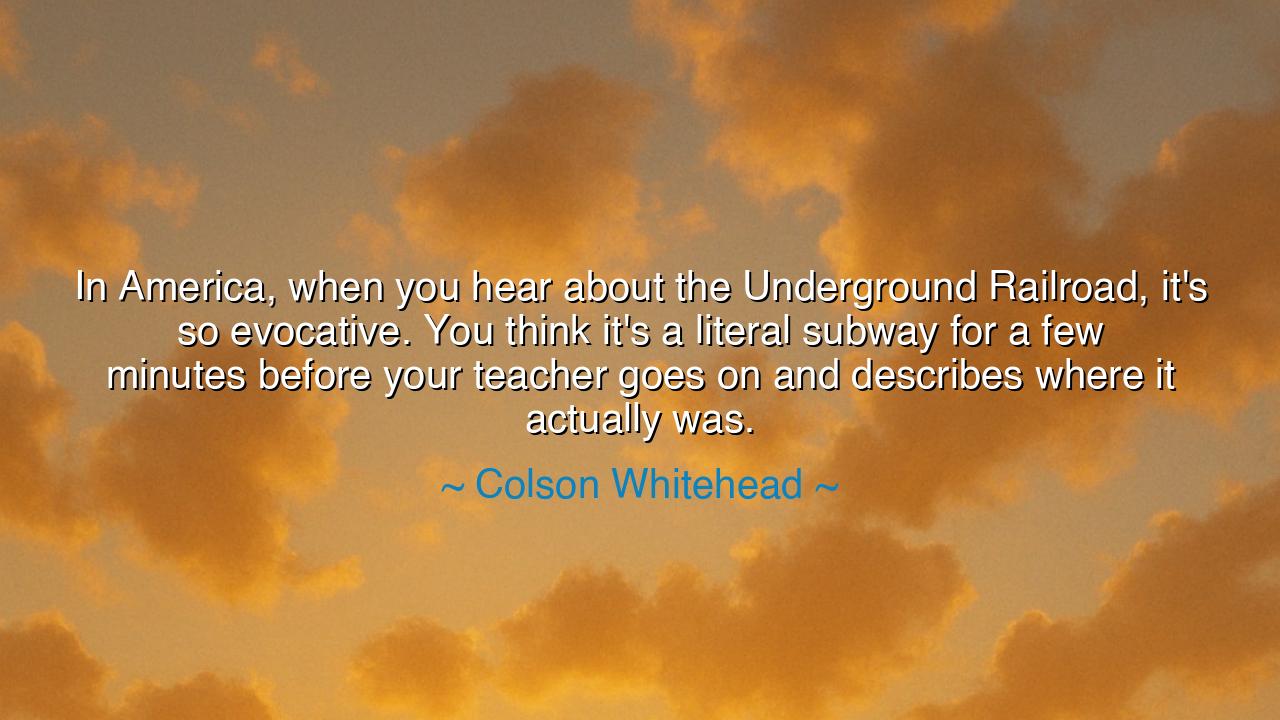
In America, when you hear about the Underground Railroad, it's
In America, when you hear about the Underground Railroad, it's so evocative. You think it's a literal subway for a few minutes before your teacher goes on and describes where it actually was.






The words of Colson Whitehead—“In America, when you hear about the Underground Railroad, it's so evocative. You think it's a literal subway for a few minutes before your teacher goes on and describes where it actually was”—echo with both wonder and sorrow. At first they capture the innocence of a child’s mind, imagining a grand railroad beneath the earth, carved by human hands, carrying the enslaved swiftly toward freedom. Yet the truth is far different, more humble, more perilous, and far more profound. For the Underground Railroad was no iron track laid in darkness, but a secret network of human hearts, a chain of courage and sacrifice that defied the cruelty of bondage.
The origin of this evocative phrase lies not in machinery, but in metaphor. The term “railroad” was borrowed from the new technology of the age, when locomotives thundered across the land with unprecedented speed. The enslaved and their allies used this language in whispers—“conductors,” “stations,” and “passengers”—so that their dangerous work could be cloaked in secrecy. It was never a tunnel of steel and fire, but a living path of trust, where each step forward could mean either the dawn of liberty or the shadow of death. Thus, the very name speaks to the ingenuity of those who dreamed of freedom, and to the yearning hearts of children who still imagine it as something vast and mysterious.
Consider the tale of Harriet Tubman, one of the most revered “conductors” on this railroad of the spirit. Though born into chains, she escaped the grasp of slavery and yet returned, again and again, to guide others to freedom. She traveled through forests, across rivers, beneath the stars, never armed with more than her faith and her resolve. She led men, women, and children along secret paths, sometimes threatening to shoot deserters, for turning back meant betrayal and death for all. In her life we see that the Underground Railroad was not made of wood or stone, but of courage as unbreakable as iron.
The evocative imagery of a hidden subway captures the imagination, but the reality is more stirring still. For what is more wondrous: a tunnel of brick, or a people who risked all to lift one another from despair? What is more powerful: trains roaring in darkness, or souls bound together in the light of a shared destiny? Whitehead’s words remind us that truth itself can be greater than imagination, that the lives of those who came before us bear lessons more profound than the fancies of the child’s mind.
Yet the quote also carries a quiet lament. How easily we forget, or fail to teach, the real meaning of the Underground Railroad. Too often the story is softened, the sharp edges dulled, until it is no more than a tale of escape, rather than a testament to resistance, sacrifice, and unity. When children first mishear it as a literal subway, it is an innocent mistake. But when adults fail to pass on its full weight, that is a graver error, a betrayal of memory. To preserve freedom, one must also preserve the stories of how it was won.
From these words arises a lesson for us today: that names and metaphors may enchant us, but we must seek the deeper truth they conceal. Behind every symbol is a lived reality, often written in blood, tears, and unyielding hope. To honor the past, we must teach it clearly, not as myth but as history alive with pain and triumph. We must remember the countless unnamed who walked the secret paths of that railroad, never recorded, never celebrated, yet vital to its existence.
What, then, shall we do? Let us study the past not as distant tales but as living guidance. Let us tell our children the truth of the Underground Railroad, not merely the poetry of its name. Let us honor Harriet Tubman, Frederick Douglass, and the countless others by carrying forward their spirit—by standing with the oppressed, by defending freedom wherever it trembles, by lending our hands to the weary and our voices to the silenced. And in our daily lives, when we see injustice, let us ask: am I a conductor of hope, or a bystander in silence?
Thus, Colson Whitehead’s words remind us of both the wonder and the weight of history. The Underground Railroad is more than an evocative phrase—it is a symbol of humanity’s power to defy chains, a lesson carved into the marrow of America, and a torch that must never be allowed to fade. For as long as we remember its truth, we, too, may find the courage to build railroads of the spirit, carrying souls toward freedom across the generations.






AAdministratorAdministrator
Welcome, honored guests. Please leave a comment, we will respond soon